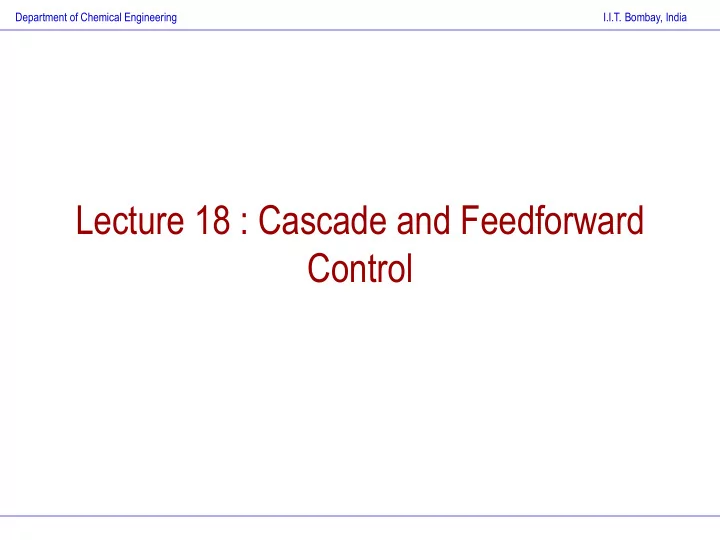

Department of Chemical Engineering I.I.T. Bombay, India Lecture 18 : Cascade and Feedforward Control
Department of Chemical Engineering I.I.T. Bombay, India Effect of disturbances in feedback control d 1 d 2 y d + y C P - Traditional feedback control strategies cannot handle processes with significant disturbances. Even if they could, corrective action is taken only after the disturbance affects the process Perfect Control is generally not possible using feedback only.
Department of Chemical Engineering I.I.T. Bombay, India Transients in the Steam header affects steam flow rate (From text)
Department of Chemical Engineering I.I.T. Bombay, India Possible Remedies If the disturbances can be measured and a good model of the disturbance dynamics is available, it may be possible to employ a more complex control structure for better regulation. If the disturbance is closer to the input side, better regulation is possible through the use of cascade control structure. If the disturbance is closer to the output side, better regulation may be possible through the use of feedforward control structure. The schemes may require additional sensors and detailed characterization of the disturbances, but better regulation may offset these costs.
Department of Chemical Engineering I.I.T. Bombay, India Cascade scheme for the reboiler (From text)
Department of Chemical Engineering I.I.T. Bombay, India Analysis of the cascade scheme
Department of Chemical Engineering I.I.T. Bombay, India Reduced block diagram The new transfer functions g 1 * and g 2 * represent the inner closed loop and Therefore, if shaped properly, could yield good overall closed loop behaviour
Department of Chemical Engineering I.I.T. Bombay, India Requirements for Cascade Control Cascade Control needs to be implemented only if traditional single loop feedback fails. Presence of a measured secondary variable is a must. It must indicate the occurrence of a disturbance. Its dynamics must be significantly faster than the primary dynamics (at least three times as as the primary). Measurements need only be precise not necessarily accurate . Disturbances that affect the secondary (slave) variable are detected and eliminated early.Controllability of the outer loop is improved because the inner loop speeds up the response.
Department of Chemical Engineering I.I.T. Bombay, India Tuning considerations in Cascade Control Master Controller is like the traditional controller in a feedback loop. Slave controller has to ensure that changes in its setpoint are adhered to. Typically tuning is doing from the inner loop to the outer loop - the inner loop must be tuned very “tightly” ( typically a high gain controller). - the outer loop may be tuned using traditional methods. In general, integral mode is not used in the slave controller, especially if gain is limited by stability. However, it may be used if large disturbances affect the process and the offset will affect the primary process variable. Derivative mode compensates for sensor lag or loop deadtime and allow for a higher slave controller gain.
Department of Chemical Engineering I.I.T. Bombay, India Typical slave loops in the process industry-- Flow Loop Flow loops are quite commonly seen as slave loops in cascade schemes. They have rapid dynamics and are amenable to be driven by remote set-point changes. Example: Reflux flow in a distillation column Flow transmitter as a sensor is quick and also cancels nonlinearities. Flow controller is typically tuned tight with a PI scheme with the integral time set equal to the valve time constant. A high gain will take care of the hysterisis or deadband in the valve (valve stiction etc).
Department of Chemical Engineering I.I.T. Bombay, India Typical slave loops in the process industry-- Flow Loop T sp FI TI C C L FT C TT
Department of Chemical Engineering I.I.T. Bombay, India Other choices for the slave loop Temperature can be a slave variable if sensor lag is taken care of by adding derivative action the derivative action must act on the measured variable only and not on the error to prevent two derivative units in series. In a reactor control problem, temperature has the advantage over coolant flow as it compensates for disturbances in coolant header pressure and temperature. Pressure is a good slave variable to use as it can be measured easily, fast and reliably. Example : Distillation column reboiler where pressure determines the steam condensing temperature and hence the heat transfer rate.
Department of Chemical Engineering I.I.T. Bombay, India Illustrative examples Cascade Control Single loop control [From Marlin (1995)]
Department of Chemical Engineering I.I.T. Bombay, India Illustrative examples Three level cascade Other cascade schemes [From Marlin (1995)]
Recommend
More recommend